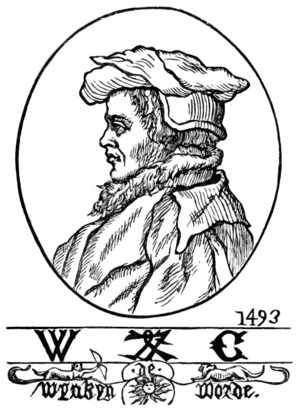Wynkyn de Worde facts for kids
Wynkyn de Worde (died around 1534) was a very important printer and publisher in London. He worked with William Caxton, who brought the printing press to England. Wynkyn de Worde is known for making printed books popular for many people across England.
Contents
What's in a Name?
Wynkyn de Worde came to England from Germany. His name was spelled in many different ways, like Wynken de Worde or Wijnkijn de Worde. "Wynkyn" is a shorter version of the name "Wynand."
Sometimes, he was also called "John Wynkyn" in old records. This has made historians wonder what his true name was. Some think his real name was John Wynkyn, and "de Worde" was just a place name. Others believe his real name was Wynkyn de Worde, and "John" was a name he sometimes used.
Life and His Printing Work
Wynkyn de Worde was probably born in a place called Wörth, either in Alsace or the Palatinate region. People used to think he came to England with William Caxton in 1476. But now, many believe he arrived a bit later, around 1481. Caxton might have brought him to England to help with the growing competition in printing.
Wynkyn de Worde married a woman named Elizabeth while he was in England. He made Caxton's printing even better. Some say he was "England's first typographer" because he improved how books looked. After Caxton passed away in 1492, Wynkyn de Worde took over his printing business in 1495.
Making Books for Everyone
Wynkyn de Worde helped move English printing from its early days into a more modern style. Caxton often relied on rich people to support his printing. While Wynkyn de Worde also had supporters, like Lady Margaret Beaufort, he changed his focus. He started making books that were less expensive. This helped create a bigger market for books, so more people could buy them.
He also used paper made in England by John Tate, the first English papermaker. Before this, paper was usually brought in from other countries. Wynkyn de Worde printed over 400 different books, some in many editions. Many of these books are now very rare.
His most successful book was a Latin grammar by Robert Whittington, which he printed 155 times! Most of his books were about religion, which was common back then. But he also printed many other kinds of books. These included romantic stories, poetry, and even books for children. He also printed books about how to run a household or care for animals.
New Ideas in Printing
Wynkyn de Worde was very creative with how he used pictures in his books. Caxton only used woodcut pictures in about 20 of his books. But Wynkyn de Worde included illustrations in 500 of his books!
He moved his printing business from Westminster to London. He was the first printer to set up shop on Fleet Street in 1500. For many centuries after that, Fleet Street became famous for printing. He was also the first to open a book stall in St Paul's Churchyard. This area soon became a main spot for buying and selling books in London.
Today, you can find a plaque marking where Wynkyn de Worde's press was. It is on a wall near St Paul's Cathedral in London.
Wynkyn de Worde was also the first to use italic type in English books in 1528. He also used Hebrew and Arabic letters in 1524. In 1495, his version of Polychronicon was the first English book to use movable type to print music.
His legacy continues today with the Wynkyn de Worde Society. This group was started in the United Kingdom in 1957. It is for people who care about excellent printing and all parts of making books.
Books He Printed
Here are some of the books that Wynkyn de Worde printed:
- Treatise of Love
- Le Morte d'Arthur (a famous story about King Arthur)
- Vitae Sanctorum Patrum
- Bartholomaeus de Proprietatibus Rerum
- The Chastising of God's Children
- Dives and Pauper
- The Book of Saint Albans
- The Canterbury Tales (a very famous collection of stories)
- Contemplacyon of sinners
- Mandeville's Travels
- Beves of Hamtoun
- Guy of Warwick
- The Squire of Low Degree
- Robin Hood
- The Miracles of Our Lady
- Golden Legend
- Ordynarye of Crysten Men
- The Rote or mirror of Consolation
- The Twelve profits of tribulation
- The Bowge of Court
- The History of the Three Kings of Cologne
- The Ship of Fools
- Mundus et Infans (1522)
- Gesta Romanorum
- Christmasse Carolles



